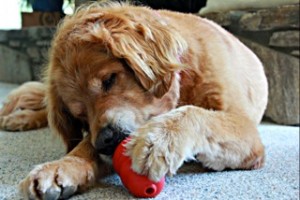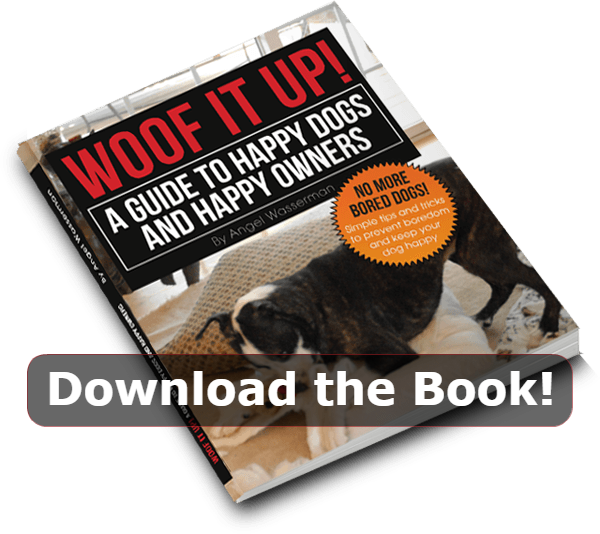Dogs rely on predictable daily routines to keep them balanced and happy. Thanksgiving naturally brings a change in your dog’s daily routine, especially if you are hosting the holiday dinner.
The following tips will help ensure that your family and your dog enjoy a safe and harmonious Thanksgiving holiday.

1. Create a safe space for your dog such as a quiet bedroom and stock the space with your dog’s bed, food and water bowls, toys and long duration chew products. If music is accessible, classical music is very soothing for dogs, just be sure to keep the volume very low. Your dog will be very thankful if he can escape to the solitude of his special place and you’ll be able to relax knowing that he is safe!
2. Prepare Thanksgiving Treats for your dog. Plan ahead to provide several, “keep busy” food toys and treats for your dog, which you can dispense during the course of the day. Frozen Kong’s can provide 45 minutes of gleeful stimulation and you can fill them with safe foods that you likely already have on hand such as plain sweet potatoes, white yogurt, canned pumpkin or high quality canned dog food. Long duration chew products such as bull horns, Nylabones, or soft deer antlers are also excellent options. It’s important to give your dog something to do while you have something to do!
3. As much as possible, keep your dog’s regular routine for feeding, play and exercise, which will help him burn off energy and feel more balanced. If possible, make arrangements with your pet sitter or doggie daycare facility for your dog to play, walk and get the exercise he needs to help him cope with the stress of the holidays.
4. Practice these food and kitchen safety steps:
- Prevent your dog from having access to the kitchen while the holiday meal is being prepared. It’s very easy to trip over a dog and if you are carrying a heavy pot or boiling liquids, you and your dog could be accidentally injured or burned as a result.
- No matter how well trained, if food is accessible to your dog, he will attempt to consume it. Thanksgiving cooking is different from day-to-day cooking and your dog is likely on olfactory overdrive from long-term exposure to cooking and baking smells. To add to his angst, food is likely lying on every surface tempting him further. Food wraps such as tin foil and Saran wrap, turkey string and paper from butter sticks are equally tempting…and dangerous. Dogs can be alarmingly quick with their movements and food or food products can be pulled from the counter before you can react.
- Move the kitchen garbage can to a place where there’s no chance that your dog can get to it. Thanksgiving “trash” is not the same as regular garbage and frankly, turkey and all the trimmings are irresistible to dogs. They don’t know that onion, garlic, mushrooms, bones and many other holiday foods are toxic to them. All they know is that the smells emanating from the garbage can are driving them crazy and that they MUST get their paws on it.
- Put your dog in his safe space while food is being placed on the table and the meal commences. It will be too hard for your dog to resist begging from visitors (especially children) and many a dangerous morsel will “accidentally” be dropped on the floor.
5. Minimize the stress of visitors and unusual activity
Don’t assume that your dog will be fine with a house full of children and other folks whom the dog may or may not know well. Everything your dog knows as normal is upside down on the holidays; expect him to act differently as a result.
Set your dog up to succeed by allowing him to mingle supervised for brief periods of time and then putting him in his safe room where he can relax and unwind.
Placing your dog on leash for these interactions will make him feel more secure and will allow you to control his movements around your visitors. Keep the interactions short to ensure the experience is positive for your dog and he does not become agitated or overexcited.
Signs of stress or over-excitement include excessive jumping, barking, mouthing, hiding behaviors, growling, lip licking, yawning and trembling.
Visitors coming and going offer many opportunities for the dog to run out the door. Ensure that your dog is wearing his ID tags in case he escapes. Assign someone in the family to leash the dog and stay with him in another room when visitors arrive or walk him on leash to greet the visitors as they arrive.
6. Your dog is a member of the family, but he’s not human
If you are feeling bad about restricting your dog’s interactions this holiday, consider this. Dogs are certainly a member of the family but they are not human and do not have the same needs as we do. Your dog does not want to be thrown into the middle of holiday chaos; what he wants is his normal routine! Limiting your dog’s interactions and movements during the holiday is not mean; rather, you are fulfilling your dog’s safety needs and helping him cope with the all the changes and stressors the holiday naturally brings.
Important links and phone numbers
There are a number of foods and holiday plants that are toxic to dogs. To obtain a list please see this Foods that are hazardous to dogs article from the ASPCA.
If you suspect that your dog has ingested a toxic food or substance, contact your veterinarian immediately. You can also call the ASPCA’s Animal Poison Control Center for help at:
888-426-4435
Charges will apply.

